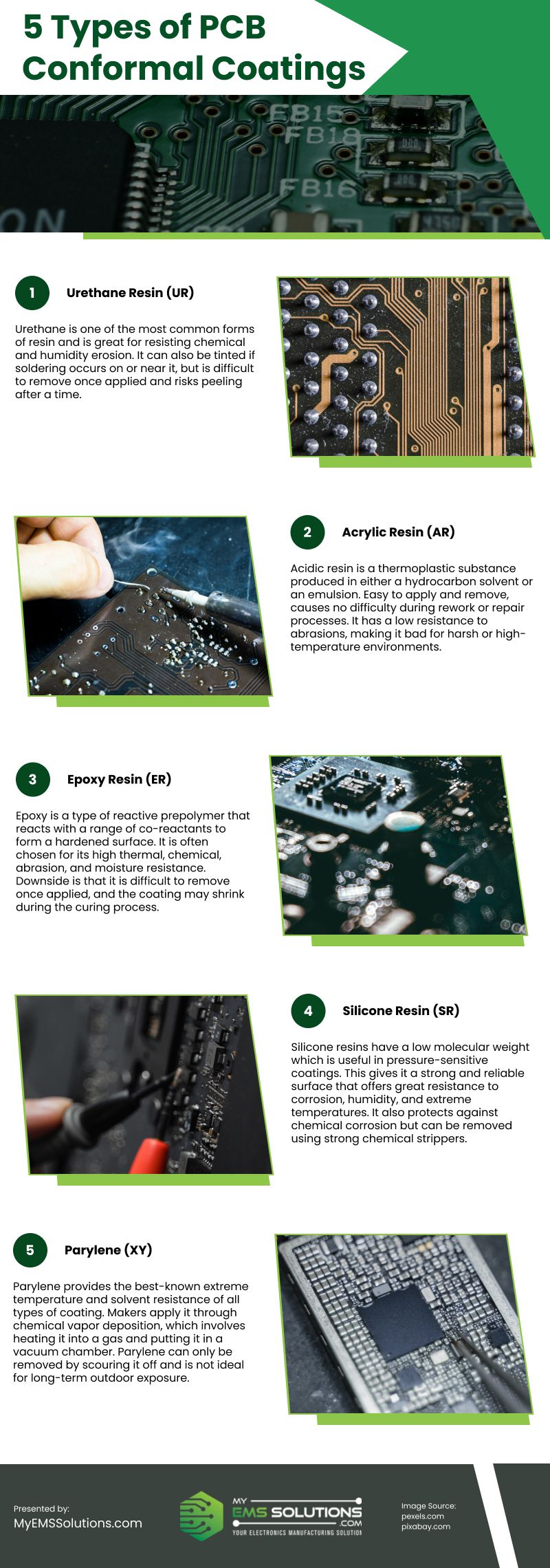
PCB conformal coating provides many advantages, such as the near-elimination of overall board weight, prevention of environmental factors leading to performance degradation, and improved protection against outside elements. This insulation layer also requires no complex enclosures surrounding the PCB itself.
However, applying the conformal coating is a complex process that requires careful consideration to achieve desired results. Poorly applied coating can lead to physical damage and failure of the PCB, which translates into costly repairs or replacement costs. Five types of conformal coating are available, each with advantages and disadvantages.
Urethane Resin (UR)
Urethane is a go-to choice for many industrial and hobbyist projects. It is an easy-to-apply liquid plastic coating that can protect against chemical erosion, humidity damage, and more. It also functions well if soldering needs to be done nearby—this often tinted resin effectively stands up against the soldering heat. Despite its versatile use cases, urethane can be challenging to remove once applied since there’s always some risk of peeling down the line.
Acrylic Resin (AR)
Acrylic resin, a thermoplastic substance sourced from acrylic acid, is convenient to use and remove in any PCB assembly procedure. It also has an inexpensive price tag compared to other coating alternatives. However, it could fare better in harsh or high-temperature atmospheres because of its low tolerance for abrasion.
Epoxy Resin (ER)
Regarding its high thermal, chemical, abrasion, and moisture resistance, epoxy is an excellent choice for those looking to protect their surfaces from harsh environments. However, it can be difficult to remove once applied, and the curing process may cause some shrinkage in the coating’s thickness. Any repairs or alterations that need to be made will also require you first remove any existing epoxy surface layer.
Silicone Resin (SR)
With their low molecular weight, silicone resins give pressure-sensitive coatings outstanding strength and trustworthiness. This protective layer can resist corrosion from humidity, extreme temperatures, and chemical corrosion. Though not easily removed without strong chemical strippers, it is one of the simplest types to apply; its excellent adhesion properties make it a great choice for PCB materials and components. Unfortunately, this resin type also hinders any attempts at repairs or modifications – requiring complete removal.
Parylene (XY)
Parylene coating is the most reputable, offering unparalleled temperature and solvent resistance. This film is applied through chemical vapor deposition (CVD). It involves heating it into gas form and depositing this vaporous material within a vacuum chamber to create an invisible finish on PCBs and other electronic components. Though there are many benefits to using parylene, it can only be removed via scouring methods; additionally, its limited durability in outdoor settings, paired with the need for specialized CVD equipment, renders it more costly than alternative options in the short term.
Manufacturers use four distinct approaches to apply conformal coating: dipping, spraying, brushing, and selecting a suitable method based on specific requirements. These tactics have advantages that make them ideal for respective applications.
When selecting a conformal coating for your PCB, it’s critical to consider its consistency over all boards—some resins are not easily repeatable. Moreover, the board’s intended use and cost must also be considered. With that said, offering extra protection and reliability to your PC components is quite simple with conformal coatings; these quickly applied resources ensure each board meets its prerequisites perfectly.
source: https://www.myemssolutions.com/pcb-conformal-coating-everything-you-need-to-know/
Comments
Download this infographic.
